Geese in Maryland are a common sight, particularly in the spring and fall when they migrate through the state. While some geese remain in Maryland year-round, most migrate south for the winter.
Head to Blackwater National Wildlife Refuge on Maryland’s Eastern Shore to experience thousands of snow geese will congregating in marshes, agricultural fields, and on the lake.
What Geese Are in Maryland?
There are four species of goose and three species of swans in Maryland.
- Canada Goose
- Snow Goose
- Cackling Goose
- Greater White-fronted Goose
Swans living in Maryland include the Tundra Swan, Trumpeter Swan and Mute Swan.
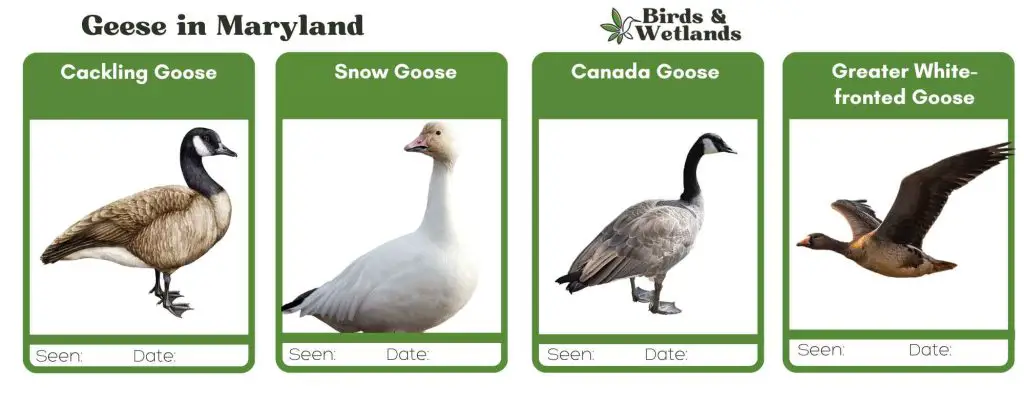
Canada Goose


Canada Goose Sound
Scientific Name: Branta canadensis
Length: 30 to 43 in
Wingspan: 50–73 in
Weight: 5.7–14.3 lb
The Canada Goose is a large, well-known species of waterfowl noted for its distinctive appearance, familiar “honk,” and migratory behavior.
Appearance: Both male and female Canada Geese have a similar appearance, featuring a black head and neck with distinctive white patches on the cheeks and chin. The body is primarily brown with a lighter, often white, underbelly.
Diet: Canada Geese primarily feed on plant matter, including grasses, aquatic vegetation, and grains. They can often be seen grazing in parks, lawns, and fields, as well as dabbling in water bodies.
Reproduction: Canada Geese typically nest on the ground near water bodies, often on islands or other isolated areas to avoid predators. The female lays a clutch of about 4 to 6 eggs, which she incubates alone for around a month.
Snow Goose

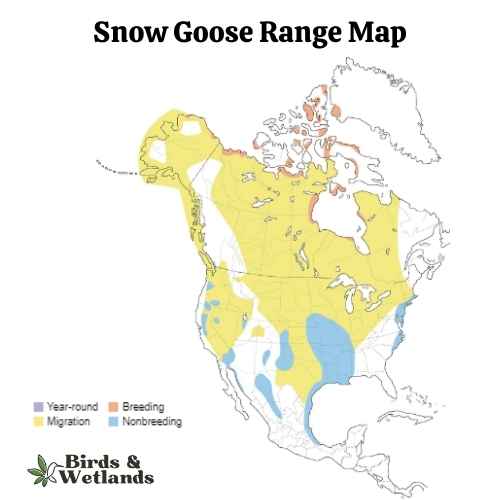
Snow Goose Sound
Scientific Name: Anser caerulescens
Length: 25 to 31 in
Wingspan: 53 to 65 in
Weight: 4.5 to 6.0
The Snow Goose is a large species of waterfowl known for its vibrant white plumage and significant migratory flights.
Appearance: True to their name, Snow Geese are predominantly white with black wingtips. They also have a pink bill, pink legs and feet. A color morph, known as the “Blue Goose,” displays a bluish-gray body with a white head, but is considered the same species.
Diet: Snow Geese primarily feed on plant matter, such as grasses, sedges, and small grains. They can often be seen in large flocks foraging in fields and marshes, and during migration and winter, they can cause considerable damage to agricultural fields due to their feeding habits.
Reproduction: Snow Geese typically nest on the tundra, near water bodies. The female builds the nest and lays a clutch of about 3 to 5 eggs, which she incubates alone for approximately three weeks. Once hatched, the goslings can feed themselves but stay with their parents for protection until they can fly.
Cackling Goose
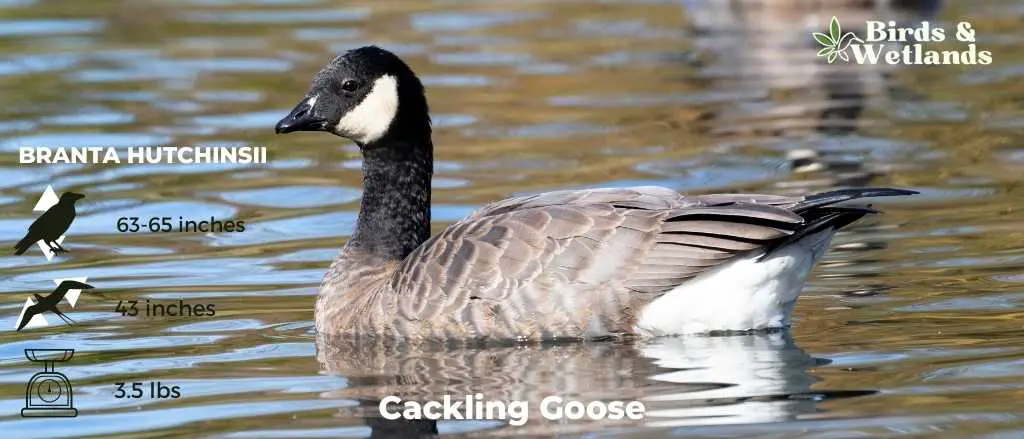
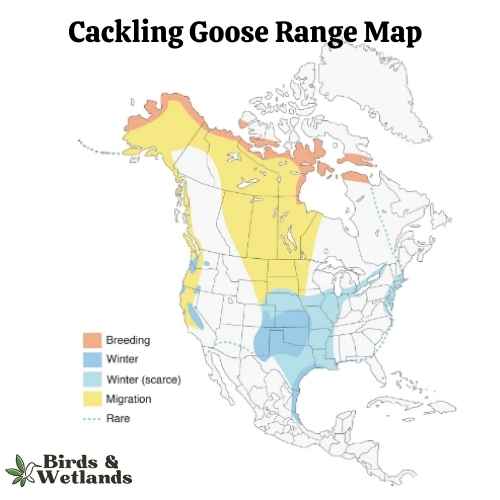
Listen
Scientific Name: Branta hutchinsii
Length: 24.8–25.6 in
Wingspan: 43-45.7 in
Weight:3.5 lbs
Cackling Geese are particularly known for their high-pitched, cackling calls, which is the source of their name. Despite their small size, these geese are renowned long-distance migrants, with some populations traveling thousands of miles between breeding and wintering grounds.
Appearance: With a similar color pattern to the larger Canada Goose, the Cackling Goose features a black head and neck, white chinstrap, light tan to cream chest, and brownish-grey body. One defining characteristic is its noticeably smaller size and stubbier neck compared to its larger counterparts.
Diet: Like many geese, the Cackling Goose’s diet mainly consists of plant matter. This includes grasses, seeds, and aquatic vegetation. They are often seen grazing on land or dabbling in shallow water.
Reproduction: Cackling Geese usually nest on the ground in elevated areas near water bodies, such as riverbanks or lakeshores. The female lays a clutch of 2 to 8 eggs and is responsible for incubation, while the male stands guard nearby. Incubation lasts for about a month.
Greater White-fronted Goose
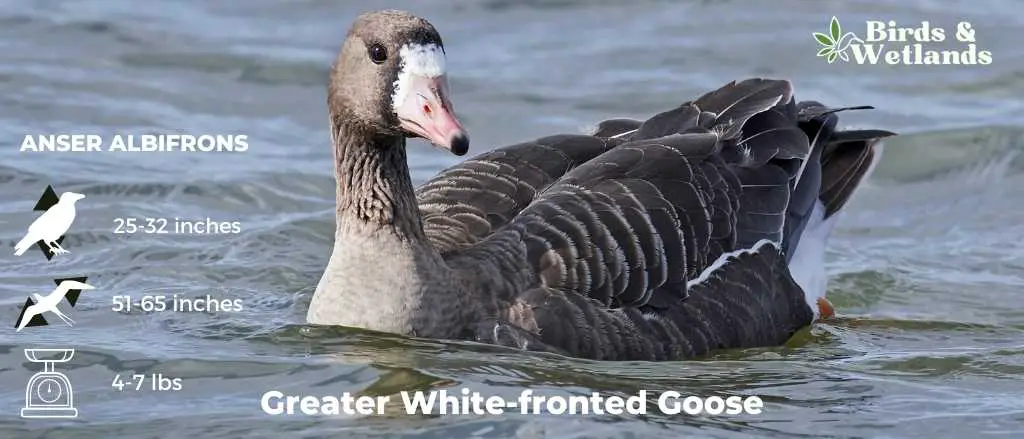

Listen
Scientific Name: Anser albifrons
Length: 25 to 31 in
Wingspan: 53 to 66 in
Weight: 3.3 to 6.6
The Greater White-fronted Goose is a medium to large waterfowl species, widely distributed across the Northern Hemisphere, particularly in North America.
Appearance: As the name suggests, these geese display a prominent white patch at the base of their bill. Their bodies are gray-brown, and their breasts are often marked with dark blotches. They possess a pinkish bill and orange legs and feet.
Diet: The Greater White-fronted Goose is a herbivore and feeds mainly on plant material. Its diet consists of grasses, sedges, grains, and berries. When wintering, these geese can often be found in agricultural fields, feasting on leftover grains and crops.
Reproduction: This species nests on the ground, often in areas with good visibility such as slopes or ridges. The female lays a clutch of 4 to 5 eggs, which she incubates for nearly a month. Once hatched, the young ones are taken care of by both parents until they are able to fly.
Waterfowl Hunting in Maryland
In Maryland, anyone 16 years of age or older must have a Maryland hunting license, Federal Migratory Bird Hunting and Conservation Stamp, commonly referred to as a hunting license, to hunt migratory game birds such as brant, coots, ducks and geese.
Can You Shoot a Goose in Maryland?
Yes, you can shoot geese in Maryland as long as you follow the state regulations and have a valid maryland hunting license – it is called the goose hunting capital of America!
A non-toxic shot is required for hunting waterfowl and coots. This means that you cannot use or possess lead shots while hunting.
You also are limited to using a nontoxic shot that is size number T (0.20 inches in diameter) or smaller.
Any non-toxic shot approved by the U.S. Fish and Wildlife Service will be legal to possess and use in Maryland. The hours of hunting are one half hour before sunrise and after sunset.
These are Maryland’s daily bag and possession limits on geese:
| Dates | Daily Bag | Possession | |
| Brant | Nov. 16–Nov. 25 Dec. 15–Jan. 31 | 2 | 6 |
| Early Resident Canada Goose | EASTERN ZONE – Sept. 1–15 WESTERN ZONE – Sept. 1–24 | 8 | 24 |
| Migratory Canada Goose (Atlantic Population) | Dec. 17–Jan. 2 Jan. 13–Jan. 31 | 1 | 3 |
| Late Resident Canada Goose Season | Nov. 19–Nov. 25 Dec. 12–Mar. 7 | 5 | 15 |
| Light Goose Statewide Season | Oct. 1–Nov. 25 Dec. 12–Jan. 31 Feb. 4 | 25 | none |
| Light Goose Conservation Order Season | Nov. 28–Dec. 10 Feb. 1–Feb. 3 Feb. 6–Apr. 15 | none | none |
Special Sea Duck Zone – duck bag limit hunters make takt 15 coots per day during the migratory game bird seasons and for hunting light geese.
Where Can I Hunt Geese in Maryland?
If you’re looking to do some goose hunting in Maryland, there are a few great places to try. The Eastern Shore is a popular spot, with plenty of wide open spaces perfect for setting up a blind.
Millington WMA is another great option, with over 4,000 acres of woods and fields to explore.
Sassafras NRMA is a bit smaller, but it’s still a great place for bird hunting.
Finally, Blackwater National Wildlife Refuge is a beautiful spot for nature lovers, and it just so happens to be home to a large population of geese.
Geese hunting locations in Maryland depend on the goose species as well as the season. You can check the complete list of geese hunting spots in Maryland here.
What kind of geese are in Maryland?
Maryland hosts a variety of geese, most notably the Canada Goose. This bird is prevalent across the state, recognizable by its black head, white cheeks, and honking call. Lesser known but also present is the Snow Goose, which typically has white plumage. Maryland’s diverse habitats provide ample opportunities for birdwatchers to spot these and other waterfowl species.
What kind of geese are in the Chesapeake Bay?
The Chesapeake Bay is a hotspot for waterfowl. The Canada Goose is particularly abundant here, but during migration seasons, the bay also sees the Snow Goose and the rare Ross’s Goose. These birds flock to the bay’s brackish waters for its rich food sources and suitable habitats, making it a prime location for bird enthusiasts.
Where do geese from Maryland migrate to?
Geese in Maryland, like the migratory canada geese, typically migrate southward for the winter. They often head to the southeastern United States, seeking milder climates. Some travel as far as northern Mexico. These migrations ensure they find suitable habitats and food sources throughout the colder months.
Do geese migrate in Maryland?
Yes, geese do migrate in Maryland. Primarily, the Canada Goose is known for its migratory patterns in the state. As winter approaches, these geese fly south to escape freezing temperatures and return northwards during spring. However, it’s worth noting that there are some resident Canada Geese populatons due to abundant food sources and milder winters.
Maryland, with its diverse ecosystems, is a haven for many migratory birds. Among these are various types of geese, most prominently the Canada Goose. However, the state also witnesses the presence of the Snow Goose, often referred to as the “white goose” in Maryland.
Historically, these geese migrated from the Arctic tundra, their primary breeding grounds. The vast tundra offers ample nest sites, where during the breeding season, geese lay their eggs and wait for them to hatch. But, as seasons change, they fly south in search of warmer habitats.
Interestingly, not all of these geese leave Maryland. Golf courses have inadvertently become attractive spots for resident geese, largely due to the expansive grassy areas and water features they offer. This adaptation has led to a noticeable increase in goose droppings on these greens, much to the chagrin of golfers and maintenance staff alike.
While migratory cousins continue their age-old patterns, these resident geese have found comfort in Maryland year-round, sidestepping the long journey to the Arctic tundra. However, their presence, especially during Maryland goose season, has made snow goose hunting in Maryland a popular activity.

